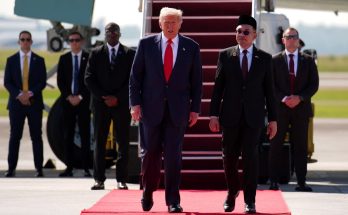E lections-2014 has thrown up for the first time in 30 years a parliament in which the Treasury Bench does not have to do number-crunching all the time, to push policy initiatives, legislative initiatives and even budgets – which have more often than not been passed in the midst of din and dust, with no one left any wiser on what was proposed or whatever was discussed.
lections-2014 has thrown up for the first time in 30 years a parliament in which the Treasury Bench does not have to do number-crunching all the time, to push policy initiatives, legislative initiatives and even budgets – which have more often than not been passed in the midst of din and dust, with no one left any wiser on what was proposed or whatever was discussed.
After Rajiv Gandhi of the Congress was voted to power in the 1984 elections that followed the Indira Gandhi assassination, India has now voted in BJP’s Narendra Damodar Modi with a substantial, if not as huge a margin. If Rajiv Gandhi’s victory was tinged with the voter-sympathy after the assassination, nothing of the sort happened this time. It was plain and simple, a vote against the Congress – and a vote for Modi, than against Rahul Gandhi and for the BJP.
The victory had been predicted for long, but this was also the first time, the pollsters had got it right, if under-estimating the BJP-NDA’s victory by a length is consolation and explanation enough. More importantly, the BJP, having shed its traditional BJD (Orissa) and JD-U (Bihar) allies, and making big forays into the North-East, has emerged as a true ‘national alternative’ to the Congress.
Whether on both counts, the party can retain the current position will also be a challenge for the Modi leadership. Yet, unlike all seven predecessors after Rajiv Gandhi, including BJP’s very own Atal Behari Vajpayee, Modi, in his Sixties, comes with the hope of being, and wanting to stay on in power for some time, if he and his government/governance can help it in the next five years.
If that happens, Modi would be the first, after immediate Congress predecessor Manmohan Singh to become a multi-term prime minister outside of the Nehru-Gandhi family. In their time, the late P V Narasimha Rao had broken what critics of the Congress would dub ‘dynasty rule’ for the family’s Congress Party, followed by Vajpayee for the non-Congress pantheon. Should he fail – for which the chances are equal, if one went again by the Rajiv Gandhi precedent – the question of ‘stability at the Centre’ could arise all over again, with political and socio-economic consequences for the nation and its teeming populace.
Where from ‘Gujarat model’
Yet, it’s all in the future. Just now, the people expect a total deviation from the immediate past, and a way forward into the future, again for the nation as a whole. It’s unclear as yet, how and why the Indian voter made him the choice, though the choice had become predictable after a time – beating the BJP’s claims of the kind on earlier occasions, which fell short by the mile.
It’s easy for the incoming government and the prime minister to assume that the voter has acknowledged the ‘Gujarat model’ of government and governance, for replicating the same at the national-level. Shorn of the corruption charges, at times wild, which however had clouded the image and functioning of the Manmohan Singh through the two-term, 10 years, and early clearances for investment-projects, much of which is now tied down to judicial clearances, from which there is no escaping, the ‘Gujarat model’ has to go beyond just that.
This model or any other model can make a difference to the voter-psyche, only if investment-linked development has to change the life, livelihood and life-style of the common man for the better, after the past decade of stagnation first and retardation, later. The voter has little patience for ism’s, and the BJP, through its high-pitched propaganda of the past decades, has educated him enough to expect results yesterday.
The voter has proved to be a cruel master in the case of the BJP once — with Vajpayee as Prime Minister – and the Congress, any number of times, including this one. There is thus a message in the Congress’ return to power every time, though this time, the party’s adversaries in power would have to work overtime to lose their sheen for their national rival to even hope to make it to the centre-stage all over again. The politics of ‘bipartisan cooperation’ that Modi promised at the end of the nine-phase polls (which went mostly unreported) has a message for the party and its government.
Stable govt, strong leadership
Through the poll-campaign, Modi and his party have promised a lot of things to lots of sections of the people, polity, et al. The voter apart, Modi in particular made strong statements, at times unsustainable and even unjustifiable, on issues of foreign and security policies. Converting expectations into intention and intention into action are different things.
Modi’s statements on Pakistan in Jammu and Kashmir, against China in the North-East and illegal Bangladeshi migrants while campaigning in West Bengal will be discussed and dissected in the coming weeks and months. So will be his observations, particularly when in Tamil Nadu, for involving State Governments in foreign-policy formulation in the immediate neighbourhood, would also be watched with interest, both inside and outside the country – particularly how the new government balances the demands of larger national interests and the sentiments of a region and its people with historic affinities to peoples across the border.
When border or borders are in question, the Modi leadership’s handling of internal security issues will be watched with greater interest and equal concern, both within the country and elsewhere, too. Considering that the American super-power is still wriggling its hands on how to handle the prospective prime minister of the world’s largest democracy after denying him visa as chief minister holds a lesson in itself. The two will invariably linked to the ‘communal situation’ in the coming weeks, months and years, which has the potential to implode, explode or diffuse so very completely, too will be watched with confused concern, all the same.
Retracing footsteps
The BJP learnt it the hard way – and did not really succeed in the learning process – after the euphoria created by ‘Pokhran-II nuclear tests’ first, and the limited and delayed victory in the ‘Kargil War’, could not sustain the Vajpayee Government beyond a point. Both before and after Vajpayee, the Modi leadership now also has before it the past histories of the Congress rival particularly in power – how they proved successful one day and why they failed the very next.
In this, Modi only need to retrace the footsteps of his immediate predecessor, who was once worshipped by India Inc and the rest as the god-sent messiah of economic reforms one day, but condemned as ineffective and lethargic not very long after. It is true not only of India, but then, wherever he is, the voter likes to punish more than reward his political masters.
There is a lesson in it, for every political leader across the country, starting with those who hoped to outsmart Modi and outdo the BJP-NDA, of which the Congress was only one! After all, politics is one of possibilities, and no one should be surprised if the anti-BJP parties and groups begin number-crunching, if not immediately, as they had tired of doing against the Congress since the Seventies. That would also be an acknowledgement that the BJP had arrived after all, and that’s when the party has to be extra careful, more about itself than about others.
(The writer is a Senior Fellow at Observer Research Foundation, Chennai Chapter)
Courtesy-ORF
Author Profile
Latest entries
 DiplomacyDecember 28, 2015Maldives 2016: At multiple cross-roads
DiplomacyDecember 28, 2015Maldives 2016: At multiple cross-roads DiplomacyDecember 23, 2015Maldives: Adopting the China model?
DiplomacyDecember 23, 2015Maldives: Adopting the China model? DiplomacyDecember 7, 2015Chennai floods: Has it anything to do with climate change?
DiplomacyDecember 7, 2015Chennai floods: Has it anything to do with climate change? DiplomacyNovember 13, 2015Maldives: End of emergency, what next?
DiplomacyNovember 13, 2015Maldives: End of emergency, what next?







